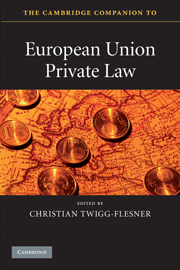Book contents
- Frontmatter
- Contents
- Preface
- List of Contributors
- Table of cases
- Table of legislation
- 1 Introduction
- 2 The historical evolution of European private law
- 3 European private law and the comparative method
- 4 The role of the conflict of laws in European private law
- 5 Competence and European private law
- 6 Language and terminology
- 7 European private law by directives
- 8 The European Court of Justice as a motor of private law
- 9 European contract law
- 10 The way forward in European consumer contract law
- 11 Commercial contracts and European private law
- 12 European tort law
- 13 European Union property law
- 14 Information obligations and withdrawal rights
- 15 Travel law
- 16 Unfair contract terms
- 17 Unfair commercial practices and European private law
- 18 Consumer sales and associated guarantees
- 19 Product liability
- 20 Commercial agency in European Union private law
- 21 EU competition law and European private law
- 22 Non-discrimination and European private law
- 23 Financial services in European Union private law
- Further reading
- Index
3 - European private law and the comparative method
Published online by Cambridge University Press: 05 July 2015
- Frontmatter
- Contents
- Preface
- List of Contributors
- Table of cases
- Table of legislation
- 1 Introduction
- 2 The historical evolution of European private law
- 3 European private law and the comparative method
- 4 The role of the conflict of laws in European private law
- 5 Competence and European private law
- 6 Language and terminology
- 7 European private law by directives
- 8 The European Court of Justice as a motor of private law
- 9 European contract law
- 10 The way forward in European consumer contract law
- 11 Commercial contracts and European private law
- 12 European tort law
- 13 European Union property law
- 14 Information obligations and withdrawal rights
- 15 Travel law
- 16 Unfair contract terms
- 17 Unfair commercial practices and European private law
- 18 Consumer sales and associated guarantees
- 19 Product liability
- 20 Commercial agency in European Union private law
- 21 EU competition law and European private law
- 22 Non-discrimination and European private law
- 23 Financial services in European Union private law
- Further reading
- Index
Summary
Introduction
In the last decade European private law has firmly established itself as a new field of academic study: with its own professorial chairs, academic journals, annual conferences and – most importantly – its own debate, European private law has turned into a real ‘industry’. Whereas for at least the last 200 years, private law was essentially a national topic, often dealing with the intricacies of national statutory provisions and case law, increasing Europeanisation has profoundly changed this, leading to a whole new and highly international field of study. The purpose of this chapter is to examine the relationship between this field and the much older discipline of comparative law. Although it is often assumed that there is a close relationship between the two fields, it is not very clear exactly what this relationship consists of. At first sight, one is inclined to say that comparison among the twenty-eight European jurisdictions is the essential tool for establishing a uniform private law for Europe. However, careful scrutiny of the European legislation in place and of the reasoning of the European Court of Justice (ECJ) may reveal a more nuanced picture.
This chapter is structured as follows. First, it is helpful to consider the relationship between legal harmonisation and the comparative method in general (section II). This allows us to look in more detail at the various ways in which the comparative method plays a role in European private law: in harmonisation through European legislation (section III); in the case law of the ECJ (section IV); and in legal scholarship (section V). Section VI contains some concluding remarks.
- Type
- Chapter
- Information
- The Cambridge Companion to European Union Private Law , pp. 33 - 43Publisher: Cambridge University PressPrint publication year: 2010



